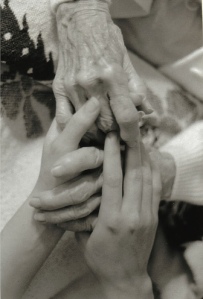♥~♥~♥~♥~♥~♥~♥~♥~♥~♥~♥~♥~♥~♥~♥~♥~♥~♥~♥~♥~♥~♥~♥~♥~♥~♥~♥~♥~♥~
 “Compassion means “to suffer with” rather than “do away with” the elderly, ill and disabled, which is the undignified bioethics of today.” Dr Wesley Smith
“Compassion means “to suffer with” rather than “do away with” the elderly, ill and disabled, which is the undignified bioethics of today.” Dr Wesley Smith
♥~♥~♥~♥~♥~♥~♥~♥~♥~♥~♥~♥~♥~♥~♥~♥~♥~♥~♥~♥~♥~♥~♥~♥~♥~♥~♥~♥~♥~
“It is not euthanasia to administer medication needed to control pain—that’s called good medical care. It is not euthanasia to stop treatment that is gravely burdensome to a patient—that’s called letting the patient exercise the moral option to refuse extraordinary medical means. It is not euthanasia to stop tube-feeding a patient whose diseased or injured body can no longer assimilate food and water—that’s called simply accepting death.” Julie Grimstad, Executive Director of Life is Worth Living, Inc.
♥~♥~♥~♥~♥~♥~♥~♥~♥~♥~♥~♥~♥~♥~♥~♥~♥~♥~♥~♥~♥~♥~♥~♥~♥~♥~♥~♥~♥~
“Soon, as our resources diminish to care for our growing aging population, we will start dealing with our elderly as we do our unborn.” Star Parker
♥~♥~♥~♥~♥~♥~♥~♥~♥~♥~♥~♥~♥~♥~♥~♥~♥~♥~♥~♥~♥~♥~♥~♥~♥~♥~♥~♥~♥~
“The solution to end-of-life suffering is, firstly to improve palliative care, and, secondly, to recognize that in the life of a rational creature like human beings, even suffering can have value if embraced with a heroic disposition.” John Jalsevac
♥~♥~♥~♥~♥~♥~♥~♥~♥~♥~♥~♥~♥~♥~♥~♥~♥~♥~♥~♥~♥~♥~♥~♥~♥~♥~♥~♥~♥~

INFORMATION FOR RESEARCH ON EUTHANASIA, PHYSICIAN-ASSISTED SUICIDE, LIVING WILLS, MERCY KILLING |
♥~♥~♥~♥~♥~♥~♥~♥~♥~♥~♥~♥~♥~♥~♥~♥~♥~♥~♥~♥~♥~♥~♥~♥~♥~♥~♥~♥~♥~
“Euthanasia is a false solution to the drama of suffering, a solution that is not worthy of man. The real answer cannot be, in fact, to give death, as ‘gentle’ as this may be, but to testify to the love that helps us to face pain and agony in a humane way.” Pope Benedict XVI
♥~♥~♥~♥~♥~♥~♥~♥~♥~♥~♥~♥~♥~♥~♥~♥~♥~♥~♥~♥~♥~♥~♥~♥~♥~♥~♥~♥~♥~
“Disabling diseases and injuries, including those for which there is a terminal diagnosis, are tragic. However, there is no such thing as a life not worth living. Every life holds promise, even if disadvantaged by developmental disability, injury, disease, or advanced aging. FRC believes that every human life has inherent dignity, and that it is unethical to deliberately end the life of a suffering person (euthanasia), or assist or enable another person to end their life (assisted suicide). While extraordinary means of life support, such as assistance with respiration and heart function, may be withdrawn from a terminally ill person if that is the person’s expressed wish, nutrition and hydration are normal and not extraordinary means of maintaining life, and severe disability is not the same as terminal illness. True compassion means finding ways to ease suffering and provide care for each person, while maintaining the individual’s life and dignity.” http://www.frc.org/euthanasia-and-end-of-life-issues Family Research Council
♥~♥~♥~♥~♥~♥~♥~♥~♥~♥~♥~♥~♥~♥~♥~♥~♥~♥~♥~♥~♥~♥~♥~♥~♥~♥~♥~♥~♥~
“Do not rebuke an older man but encourage him as you would a father, younger men as brothers, older women as mothers, younger women as sisters, in all purity.” 1 Timothy 5:1-4
♥~♥~♥~♥~♥~♥~♥~♥~♥~♥~♥~♥~♥~♥~♥~♥~♥~♥~♥~♥~♥~♥~♥~♥~♥~♥~♥~♥~♥~
“To replenish its numbers, a culture can choose to welcome sufficient numbers of immigrants or it can do what societies have usually done throughout history: have enough children. If you are not created in the image of God, (then) you’re not this eternally, sacred, beautiful creature. So you get old (and) you kind of get in the way every year. You are eating so much food and someone has to pay for you and there are not many kids left to get the jobs to pay to support you.” Eric Metaxas
♥~♥~♥~♥~♥~♥~♥~♥~♥~♥~♥~♥~♥~♥~♥~♥~♥~♥~♥~♥~♥~♥~♥~♥~♥~♥~♥~♥~♥~
“Gray hair is a glorious crown; it is found in the way of righteousness.” Proverbs 16:31
♥~♥~♥~♥~♥~♥~♥~♥~♥~♥~♥~♥~♥~♥~♥~♥~♥~♥~♥~♥~♥~♥~♥~♥~♥~♥~♥~♥~♥~
“Euthanasia can’t be something that we accept, because only God knows what’s best.” Sarah Klammer “A Teen’s Thoughts On Euthanasia” ” A Teen’s Perspective” “Clearly Caring”. Want More Teen Website Section Q: www.sectionq.com
♥~♥~♥~♥~♥~♥~♥~♥~♥~♥~♥~♥~♥~♥~♥~♥~♥~♥~♥~♥~♥~♥~♥~♥~♥~♥~♥~♥~♥~
♥~♥~♥~♥~♥~♥~♥~♥~♥~♥~♥~♥~♥~♥~♥~♥~♥~♥~♥~♥~♥~♥~♥~♥~♥~♥~♥~♥~♥~
When an action or medication is withheld from a patient for the primary purpose of causing or hastening death, this is passive, or indirect, euthanasia. These measures may include the with-holding or withdrawal of ordinary measures such as food, water (hydration) and oxygen.
Examples of passive euthanasia are:
- when food and water is withheld from sick or disabled newborn babies who might otherwise have lived
- with-holding or withdrawing food and water from someone who is diagnosed as being in a ‘persistent vegetative state,’ has dementia, or who is not improving fast enough (e.g. from a stroke)
- ‘do not resuscitate’ orders written on patients’ charts
Drugs
In Oregon, a doctor can write a prescription for drugs that are intended to kill the patient. When the prescription is filled, directions centre around making certain that the patient understands about taking all the pills in a single dose, dies after taking the prescription.
The lethal drugs are covered by some Oregon health insurance plans. They are paid for by the state Medicaid program under a funding category called “comfort care.”
Research into euthanasia in the Netherlands claimed people awake from comas after taking supposedly fatal drug doses and suffer side effects such as vomiting and gasping.
To reduce the chances of the euthanasia drugs being vomited up, an anti-emetic must be given.
The study showed that when patients tried to kill themselves using drugs prescribed by a doctor, the medication did not work as expected in 16% of cases. In a further 7% of cases there were technical problems or unexpected side effects.
Problems surface so often that doctors felt compelled to intervene in 18% of cases, according to a report in the New England Journal of Medicine. Even when the doctor directly performed euthanasia, complications developed in 3% of the attempts. Patients either took longer to die than expected or woke from a drug-induced coma that was supposed to be fatal in 6% of cases. 2
Injections
In the Netherlands, the practice is an injection to render the patient comatose, followed by a second injection to stop the heart.
First a coma is induced by intravenous administration of barbiturates, followed by a muscle relaxant. The patient usually dies as the result of anoxemia caused by the muscle relaxant. When death is delayed, intravenous potassium chloride is also given to hasten cardiac arrest.
Starvation and Dehydration
Right-to-die activists often advocate the withdrawal of food and water in order to hasten death. This means of death is frequently approved when application is made to the courts. Proponents of euthanasia recommend the use of what is known as Terminal Sedation in combination with the withdrawal of food and water.
Terminal sedation allows for the measured use of sedatives and analgesics for the necessary control of symptoms such as intolerable pain, agitation, and anxiety, in order to relieve the distress of the patient and of family members.
If all food and fluids (nutrition and hydration) are removed from a person — whether that person is a healthy Olympic athlete who takes food and fluids by mouth or a frail, disabled person who receives them by a feeding tube — death is inevitable. That death will occur because of dehydration.
Dr. Helga Kuhse, a leading campaigner for euthanasia, said in 1984: “If we can get people to accept the removal of all treatment and care – especially the removal of food and fluids – they will see what a painful way this is to die and then, in the patient’s best interest, they will accept the lethal injection.” 3
Gases, plastic bags and the ‘peaceful pill’
This method, referred to as ‘self deliverance,’ is most commonly advocated by right-to-die activists such as Derek Humphry and Dr Philip Nitschke. In Humphry’s book Final Exit describes the method and has been found in the possession of people who have used the method to commit suicide.
Dr Nitschke developed what he calls the ‘CO Genie’ – an apparatus that turns out lethal carbon monoxide that can be made at home. Nitschke has held workshops in Australia and New Zealand teaching people how to manufacture such devices for themselves.
Dr Nitschke’s latest initiative is a barbiturate-based ‘peaceful pill.’ Nitschke’s Peanut Project (named for an old street term for “Barbiturate”) intends holding workshops for small groups of elderly and seriously ill Exit members from different countries to make their own Peaceful Pill.
References:
- www.nzma.org.nz
- news.bbc.co.uk
- Fifth Biennial Congress of Societies for the Right to Die, held in Nice, Sept. 1984



